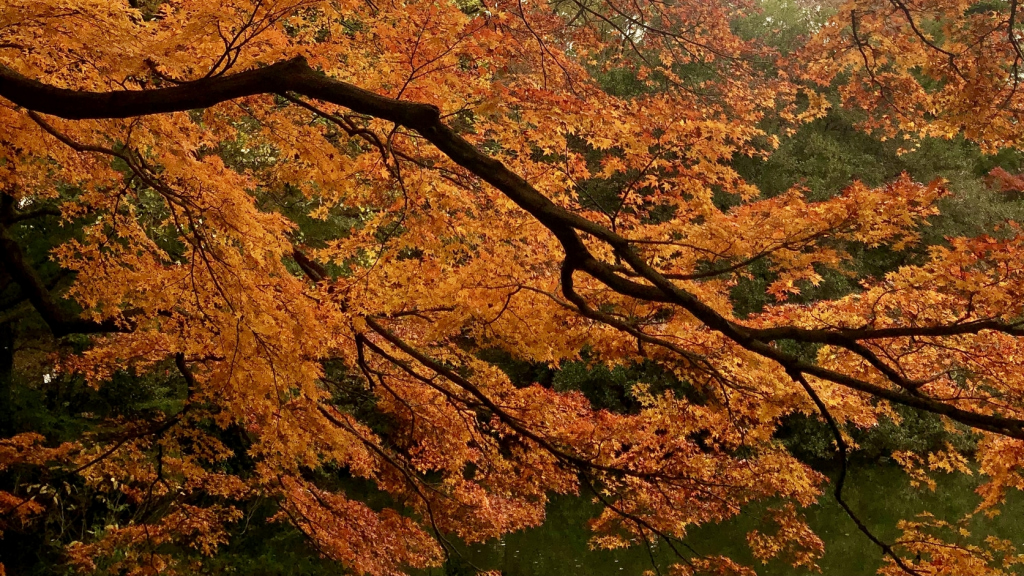Anyone who’s spent some time in Japan soon finds him or herself drawn to a seasonal gathering to look at trees. And while hanami, the spring cherry blossom “watching” week, gets most of the attention—and calls for the biggest partying among office workers—the end-of-autumn equivalent, kōyō, or “red leaves,” is a lot more sober, and, perhaps, slightly more grown up for it.
By Andy Gayler
While the leaves may soon have completely departed the trees of Tokyo, there are still plenty of places you can catch the crimson spectacle for a few weeks more. Of course, as the winter creeps from the north to the south of the archipelago, you’ll understand that south will most likely be the direction you’ll be heading. And you may want to do it as quickly as possible—the longer you leave it the further down you’ll have to go as those winter chills finally strip the trees of their last leaves. (Although you might not want to bother going as far as Okinawa because the autumn redness never really takes hold with the mostly ever-green plant life in Japan’s sub-tropical zone.)
So, where can you go if you need your Fall fix? Well, the good news is you can still enjoy kōyō in the capital, if you hurry. Rikugien, the beautiful Edo-period landscaped gardens in central Tokyo, with its many maples may be first on your list. In fact, this is thought to be one of the best times to visit the gardens as those stunning reds and golds really do seem to have the remedy for any burgeoning winter blues. The site is a 5–10 minutes walk from Komagome Station on the JR Yamanote Line or Namboku Subway Line.
Sticking with the metropolis, another Edo-era garden offers itself as a seasonal draw. Koishikawa Korakuen, near Tokyo Dome, is known for its traditional gardens and they don’t disappoint at this time of year. Iidabashi Station and Suidobashi Station are each a 5 to 10 minute walk away, and Korakuen Station is not much further.
But, if you want to get out of the city then there are numerous mountains that can be visited on a day trip. Mount Takao, for example, is less than an hour from Shinjuku Station and has numerous hiking trails, views of the big smoke and a monkey park. But it’s popular during kōyō time, so expect to be among the crowds.
Parts of Hakone are still displaying their autumn colors at this time of year, too. A boat trip on the lake under the watchful eye of a snow-capped Mount Fuji makes for a very romantic kōyō trip. The Odakyu Line from Shinjuku will get you there and back in a day—but you could stay the night and enjoy an onsen, and more kōyō the next day!
Kamakura is another all-year tourist spot that has its own autumn charm. The ancient capital holds its own for redness, but for places within easy reach of the modern capital there might not be many that can compare for the sheer number of other attractions on offer—temples, beaches, hiking trails, a big Buddha, a small island, and even a coastal train among them. Take the JR Yokosuka Line or Shonan-Shinjuku Line to get there from Tokyo (about one hour).
If you haven’t visited Kyoto yet, this may well be one of the best times to do so. Yes, it’s beautiful in and around the city during the cherry blossom season, but the reds of autumn are truly dazzling when they arrive late November. And combined with the temples and more traditional landscapes this really is one of the best places to get a sense of what all the fuss is about at this time of year.
Finally, here are a few suggestions for those looking to go a little farther afield (particularly with the long weekend coming up): the Korankei valley near Nagoya—particularly around Mount Iimori—is said to be stunning; Ise Grand Shrine in Mie combines culture and spectacular scenery; and the Izu Peninsula offers quiet onsen getaways to go with your kōyō excursions.
Have a favorite place to take in the fall foliage that’s not included here? Let us know in the comments below!
Updated On December 26, 2022








